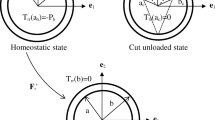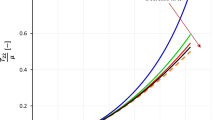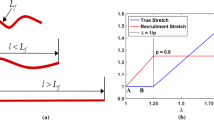Abstract
It is shown that a widely used class of constitutive models for the mechanical response of elastic arteries, which includes the so-called HGO model, responds as if it were inextensible in simple tension in the zero limit of a non-dimensional ratio of material parameters. A significant auxetic response is predicted for an incompressible hyperelastic elastic sheet reinforced with inextensible cords. Thus, a significant lateral deformation of arterial specimens modelled by this class of materials should be observed in simple tension for small values of the non-dimensional parameter. However, such a response has not been observed experimentally. The analysis therefore suggests that predictions for this class of strongly anisotropic constitutive models for arteries should be treated with caution.




Similar content being viewed by others
References
Fung, Y.C.: Biomechanics: mechanical properties of living tissues. Springer Science and Business Media (2013)
Holzapfel, G.A.: Collagen in arterial walls: biomechanical aspects. In: Fratz, P. (ed.) Collagen, pp 285–324. Springer, Boston (2008)
Roach, M. R., Burton, A. C.: The reason for the shape of the distensibility curves of arteries. Canadian J. Biochemistry and Physiology 35, 681–690 (1957)
Humphrey, J. D.: Cardiovascular Solid Mechanics. Cells Tissues and Organs. Springer, New York (2002)
Humphrey, J. D.: Continuum biomechanics of soft biological tissues. Proc. Roy. Soc. A. 459, 3–46 (2003)
Taber, L. A.: Nonlinear Theory of Elasticity: Applications in Biomechanics. World Scientific, Singapore (2004)
Ogden, R.W.: Nonlinear continuum mechanics and modeling the elasticity of soft biological tissues with a focus on artery walls. In: Holzapfel, G.A., Ogden, R.W. (eds.) Biomechanics: Trends in Modeling and Simulation, pp 83–156. Springer, Heidelberg (2017)
Holzapfel, G. A., Gasser, T. C., Ogden, R. W.: A new constitutive framework for arterial wall mechanics and a comparative study of material models. J. Elast. 61, 1–48 (2000)
Holzapfel, G. A.: Determination of material models for arterial walls from uniaxial extension tests and histological structure. J. Theor. Biol. 238, 290–302 (2006)
Adkins, J. E., Rivlin, R. S.: Large elastic deformations of isotropic materials X. Reinforcement by inextensible cords. Phil. Trans. Royal Soc. Lond. A 248, 201–223 (1955)
Ciambella, J., Saccomandi, G.: A continuum hyperelastic model for auxetic materials. Proc. Roy. Soc. A 470, 20130691 (2014)
Ciambella, J., Bezazi, A., Saccomandi, G., Scarpa, F.: Nonlinear elasticity of auxetic open cell foams modeled as continuum solids. J. Appl. Phys. 117, 184902 (2015)
Crespo, J., Montáns, F. J.: A continuum approach for the large strain finite element analysis of auxetic materials. Int. J. Mech. Sci. 135, 441–457 (2018)
Evans, K. E., Alderson, A.: Auxetic materials: functional materials and structures from lateral thinking!. Advanced Mat. 12, 617–628 (2000)
Gatt, R., Wood, M. V., Gatt, A., Zarb, F., Formosa, C., Azzopardi, K. M., Casha, A., Agius, T. P., Schembri-Wismayer, P., Attard, L., Chockalingam, N., Grima, J. N.: Negative Poisson’s ratios in tendons: an unexpected mechanical response. Acta Biomater. 24, 201–208 (2015)
Murphy, J.G., Biwa, S.: The counterintuitive mechanical response in simple tension of arterial models that are separable functions of the I1,I4,I6 invariants. Int. J. Nonlinear Mech. 90, 72–81 (2017)
Horgan, C. O., Murphy, J. G.: The counterintuitive out-of-plane strength of incompressible orthotropic hyperelastic materials. Int. J. Solids Struct. 115, 170–179 (2017)
Volokh, K. Y.: On arterial fiber dispersion and auxetic effect. J. Biomech. 61, 123–130 (2017)
Holzapfel, G. A., Ogden, R. W.: On planar biaxial tests for anisotropic nonlinearly elastic solids. A continuum mechanical framework. Math. Mech. Solids 14, 474–489 (2009)
Latorre, M., Romero, X., Montans, F. J.: The relevance of transverse deformation effects in modeling soft biological tissues. Int. J. Solids Struct. 99, 57–70 (2016)
Skacel, P., Bursa, J.: Poisson’s ratio of arterial wall–inconsistency of constitutive models with experimental data. J. Mech. Behavior Biomed. Mat. 54, 316–327 (2016)
Spencer, A. J. M.: Constitutive theory for strongly anisotropic solids. In: Continuum Theory of the Mechanics of Fibre-reinforced Composites, Spencer, A.J.M.(Ed). CISM Courses and Lectures No. 282. Springer, Vienna (1984)
Itskov, M., Aksel, N.: Elastic constants and their admissible values for incompressible and slightly compressible anisotropic materials. Acta Mech. 157, 81–96 (2002)
Holzapfel, G. A., Ogden, R. W.: Constitutive modelling of arteries. Proc. Roy. Soc. A 466, 1551–1597 (2010)
Holzapfel, G. A., Stadler, M., Schulze-Bauer, C. A.: A layer-specific three-dimensional model for the simulation of balloon angioplasty using magnetic resonance imaging and mechanical testing. Annals Biomed. Eng. 30, 753–767 (2002)
Horgan, C. O., Murphy, J. G.: Some unexpected behaviour in shear for elasticity models of arterial tissue that only use the I 1, I 4, I 6 invariants. IMA J. Appl. Math. 79, 820–829 (2014)
Murphy, J. G.: Transversely isotropic biological, soft tissue must be modelled using both anisotropic invariants. Eur. J. Mech.-A/Solids 42, 90–96 (2013)
Destrade, M., Mac Donald, B., Murphy, J. G., Saccomandi, G.: At least three invariants are necessary to model the mechanical response of incompressible, transversely isotropic materials. Computational Mech. 52, 959–969 (2013)
Pucci, E., Saccomandi, G.: On the use of universal relations in the modeling of transversely isotropic materials. Int. J. Solids Struct. 51, 377–380 (2014)
Acknowledgements
We are grateful to the reviewers for their constructive comments on an earlier version of the manuscript.
Author information
Authors and Affiliations
Corresponding author
Ethics declarations
Conflict of interest
The authors declare that they have no conflict of interest.
Additional information
Publisher’s note
Springer Nature remains neutral with regard to jurisdictional claims in published maps and institutional affiliations.
Rights and permissions
About this article
Cite this article
Horgan, C.O., Murphy, J.G. Some unexpected predictions from strongly anisotropic hyperelastic constitutive models of soft tissue. Mech Soft Mater 2, 9 (2020). https://doi.org/10.1007/s42558-020-00024-5
Received:
Accepted:
Published:
DOI: https://doi.org/10.1007/s42558-020-00024-5




